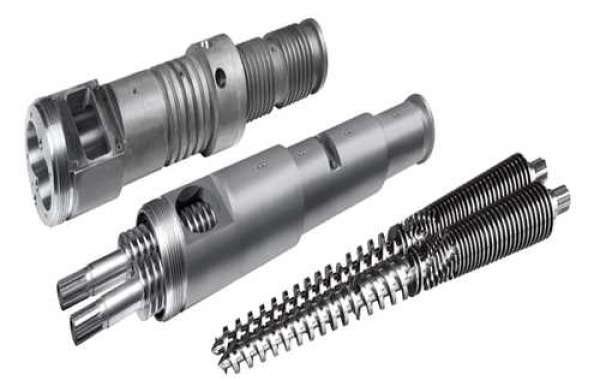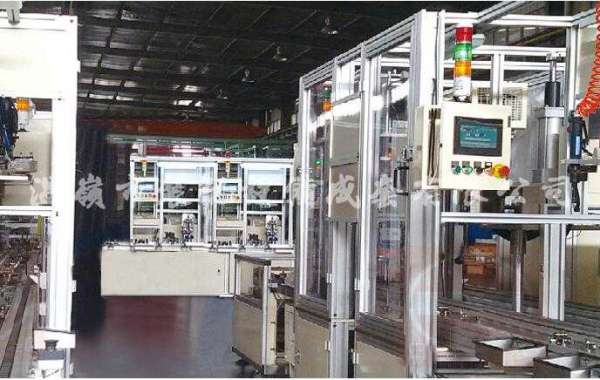What is the composition of the extruder? In the extruder, in general, the basic and common one is a single screw extruder or Bimetallic Screw Barrel . It mainly includes six parts: transmission, feeding device, barrel, screw, head and die.
The transmission part is usually composed of a motor, a reduction box and a bearing. During the extrusion process, the screw speed must be stable and cannot change with the change of the screw load, so as to maintain the uniform quality of the products obtained. However, in different occasions, the screw must be variable speed to achieve the requirement that a piece of equipment can extrude different plastics or different products. Therefore, this part generally uses AC commutator motors, DC motors and other devices to achieve stepless speed change. Generally, the screw speed is 10-100 rpm.
The function of the transmission system is to drive the screw and supply the torque and speed required by the screw during the extrusion process. It is usually composed of a motor, a reducer and a bearing. On the premise that the structure is basically the same, the manufacturing cost of the reducer is roughly proportional to its size and weight. Because of the large shape and weight of the reducer, it means that a lot of materials are consumed during manufacturing, and the bearings used are also relatively large, which increases the manufacturing cost.
Extruder
For extruders with the same screw diameter, high-speed and high-efficiency extruders consume more energy than conventional extruders. The power of the motor is doubled, and it is necessary to increase the frame size of the reducer accordingly. But a high screw speed means a low reduction ratio. For the reducer of the same size, the gear modulus of the low reduction ratio is increased compared with the large reduction ratio, and the load bearing capacity of the reducer is also increased. Therefore, the increase in volume and weight of the reducer is not linearly proportional to the increase in motor power. If the amount of extrusion is used as the denominator and divided by the weight of the reducer, the number of high-speed and high-efficiency extruders is smaller, and the number of ordinary extruders is larger. In terms of unit output, the low motor power of the high-speed and high-efficiency extruder and the small weight of the reducer mean that the cost of the unit output of the high-speed and high-efficiency extruder is lower than that of the ordinary extruder.
Feeding device
Generally, pellets are generally used for the feed, but strips or powders can also be used. The charging equipment usually uses a conical hopper, whose volume is required to provide at least an hour's consumption. There is a cutting device at the bottom of the hopper to adjust and cut off the material flow. The side of the hopper is equipped with a sight hole and a calibration metering device. Some hoppers may also be equipped with a pressure reducing device or heating device to prevent the raw materials from absorbing moisture from the air, or some barrels also have their own agitator, which can automatically feed or feed materials.
1. Hopper
The hopper is generally made in a symmetrical form. There is a window on the side of the hopper to observe the material level and feeding situation, and the bottom of the hopper has an opening and closing door to stop and adjust the feeding amount. A cover is added above the hopper to prevent dust, moisture and impurities from falling into it. When selecting hopper materials, it is easy to use lightweight, corrosion-resistant and easy-to-process materials. Generally, aluminum plates and stainless steel plates are used. The volume of the hopper depends on the size of the extruder and the feeding method. Generally, the extrusion capacity of the extruder is 1~1.5h.
2. Loading
There are two kinds of feeding methods: manual feeding and automatic feeding. Automatic feeding mainly includes spring feeding, blast feeding, vacuum feeding, conveyor belt conveying feeding and other forms. In general, manual feeding is used for small extruders and automatic feeding for large extruders.
3. Classification of feeding methods
① Gravity feeding:
Principle-The material enters the barrel by its own weight, including manual feeding, spring feeding, and blast feeding.
Features-simple structure and low cost. But it is easy to cause uneven feeding, which affects the quality of the parts. It is only suitable for small extruders.
② Mandatory feeding:
Principle-Install a device that can apply external pressure to the material in the hopper to force the material into the extruder barrel.
Features-It can overcome the "bridging" phenomenon and make the feeding uniform. The feeding screw is driven by the screw of the extruder through the transmission chain, so that its speed is compatible with the speed of the screw. The overload protection device can be activated when the feeding port is blocked, thereby avoiding the damage of the feeding device.
Barrel
Generally, it is a metal barrel made of alloy steel or composite steel pipe lined with alloy steel. Its basic characteristics are high temperature and pressure resistance, strong wear resistance and corrosion resistance. Generally, the length of the barrel is 15 to 30 times its diameter, and its length is based on the principle that the material is fully heated and plasticized uniformly. The barrel should have sufficient thickness and rigidity. The inside should be smooth, but some barrels are carved with various grooves to increase the friction with the plastic. Electric heater, temperature automatic control device and cooling system are attached to the outside of the barrel with resistance, inductance and other heating methods.
1. There are three types of barrels in structure:
(1) Integral barrel
Processing method-processed on the whole material.
Advantages-easy to ensure higher manufacturing accuracy and assembly accuracy, can simplify the assembly work, the barrel is heated evenly, and more applications.
Disadvantages-Due to the large length of the barrel, the processing requirements are high, and the requirements for processing equipment are also very strict. After the inner surface of the barrel is worn, it is difficult to repair.
(2) Combined material brief
Processing method-the barrel is processed in several sections, and then the sections are connected by flanges or other forms.
Advantages-simple processing, easy to change the ratio of length to diameter, mostly used in situations where the ratio of length to diameter of the screw needs to be changed.
Disadvantages-the processing accuracy is very high. Due to the large number of sections, it is difficult to ensure the coaxiality of each section. The flange connection destroys the uniformity of the barrel heating and increases the heat loss. The heating and cooling system is also set up and maintained. More difficult
(3) Bimetallic barrel
Processing method-inlay or cast a layer of alloy steel material inside the matrix of general carbon steel or cast steel. It can not only meet the material requirements of the barrel, but also save precious metal materials.
① Bushing type barrel: The barrel is equipped with a replaceable alloy steel bushing. Save precious metals, the bushing can be replaced, and the service life of the barrel is improved. But its design, manufacturing and assembly are more complicated.
② Casting barrel: Centrifugally cast a layer of about 2mm thick alloy on the inner wall of the barrel, and then use the grinding method to obtain the required inner diameter of the barrel. The alloy layer and the matrix of the barrel are well combined, and the combination along the axial length of the barrel is relatively uniform, and there is no tendency to peel off or cracking. It also has excellent sliding properties and high wear resistance. long life.
(4) IKV barrel
1) Longitudinal grooves are provided on the inner wall of the feeding section of the barrel
In order to improve the solids conveying rate, it is known from the solids conveying theory that one method is to increase the friction coefficient of the barrel surface, and another method is to increase the area of the material at the feeding port through the cross section perpendicular to the screw axis. Opening a longitudinal groove on the inner wall of the feeding section of the barrel and making the inner wall of a section of the barrel near the feeding port into a cone shape are the embodiments of these two methods.
2) Forced cooling of the feeding section barrel
In order to increase the solids delivery, there is another method. It is to cool the feeding section barrel, the purpose is to keep the temperature of the conveyed material below the softening point or melting point, avoid the appearance of melt film, and maintain the solid friction properties of the material.
After using the above method, the conveying efficiency is increased from 0.3 to 0.6, and the extrusion volume is less sensitive to changes in die pressure.
Screw
The screw is the heart of the extruder and the key component of the extruder. The performance of the screw determines the productivity, plasticization quality, dispersion of additives, melt temperature, power consumption, etc. of an extruder. . It is an important part of the extruder, which can directly affect the scope of application and production efficiency of the extruder. Through the rotation of the screw to produce extreme pressure on the plastic, the plastic can move, pressurize, and obtain part of the heat from the friction in the barrel. The plastic is mixed and plasticized during the movement of the barrel, viscous fluid state When the melt is extruded and flows through the die, it obtains the desired shape and is formed. Like the barrel, the screw is also made of a high-strength, heat-resistant and corrosion-resistant alloy.
The Rubber Screw Barrel has the same effect, but the objects that can be produced are different.







